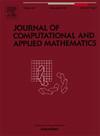计算机实验正交最大距离均匀投影设计的构造
IF 2.6
2区 数学
Q1 MATHEMATICS, APPLIED
Journal of Computational and Applied Mathematics
Pub Date : 2025-07-05
DOI:10.1016/j.cam.2025.116902
引用次数: 0
摘要
对复杂物理系统进行研究和建模的计算机实验是非常必要的。在计算机实验和物理实验中,构建具有良好空间填充性和柱正交性的实验设计是至关重要的。虽然最大距离设计和均匀设计确保了全维空间的空间填充,但它们缺乏对低维投影的保证。统一投影设计通过确保低维子空间的空间填充特性来解决这一差距。正交设计能够在高斯过程中进行有效的因素筛选,并确保线性模型中主要效应的不相关估计。然而,构建这样的优化设计仍然具有挑战性。结合这些优势的设计将优于单独的方法。本文提出了七个新的构造正交最大距离均匀投影设计的理论技术,填补了这一空白。随着因子数量的增加,所提出的设计显示出优越的性能,使它们特别适合于高维高斯过程中的代理建模和线性趋势估计。比较研究表明,所提出的技术优于现有的方法。本文章由计算机程序翻译,如有差异,请以英文原文为准。
Constructing orthogonal maximin distance uniform projection designs for computer experiments
There is a significant need for computer experiments to study and model complex physical systems. In both computer and physical experiments, constructing experimental designs with good space-filling and column-orthogonality properties is crucial. While maximin distance designs and uniform designs ensure space-filling in full-dimensional spaces, they lack guarantees for low-dimensional projections. Uniform projection designs address this gap by ensuring space-filling properties in low-dimensional subspaces. Orthogonal designs enable efficient factor screening in Gaussian processes and ensure uncorrelated estimates of main effects in linear models. However, constructing such optimal designs remains challenging. A design that combines these advantages would outperform individual approaches. This paper fills this gap by proposing seven novel theoretical techniques for constructing orthogonal maximin distance uniform projection designs. The proposed designs demonstrate superior performance as the number of factors increases, making them particularly well-suited for surrogate modeling and linear trend estimation in high-dimensional Gaussian processes. Comparative studies show that the proposed techniques outperform existing methods.
求助全文
通过发布文献求助,成功后即可免费获取论文全文。
去求助
来源期刊
CiteScore
5.40
自引率
4.20%
发文量
437
审稿时长
3.0 months
期刊介绍:
The Journal of Computational and Applied Mathematics publishes original papers of high scientific value in all areas of computational and applied mathematics. The main interest of the Journal is in papers that describe and analyze new computational techniques for solving scientific or engineering problems. Also the improved analysis, including the effectiveness and applicability, of existing methods and algorithms is of importance. The computational efficiency (e.g. the convergence, stability, accuracy, ...) should be proved and illustrated by nontrivial numerical examples. Papers describing only variants of existing methods, without adding significant new computational properties are not of interest.
The audience consists of: applied mathematicians, numerical analysts, computational scientists and engineers.

 求助内容:
求助内容: 应助结果提醒方式:
应助结果提醒方式:


